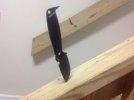Good evening everyone.
I recently purchased a sharpmaker to sharpen some of my knives. I've found that the bevel on every knife I own just so happens to be greater than 30 degrees (just my luck). I have successfully been able to re-profile my Kershaw Dimension and Kershaw Blur using some 220 grit wet/dry sandpaper. After reprofiling, both were able to take a wicked 30 degree edge from my sharpmaker.
Now, time to confront my next obstacle. I have a DPx knife with sleipner that has a pretty poor factor edge. I was hoping I'd be able to touch it up with the 40 degree setting on the sharpmaker, but the factory bevel is in excess of 40 degrees. I'm quite hesitant to re-profile this knife as I know it is a particularly hard steel, and it cost me a lot of money. Additionally, because the blade is so thick, a lot of metal will have to be removed. On the plus side, my HEST has a very basic blade shape so I feel it will be easier to re-profile than my blur.
I'd rather not spend a lot of money, as I just purchased the sharpmaker. The diamond rods are a bit out of my budget and I heard they wear out quickly (I'd imagine this becomes more true with a hard steel such as SLEIPNER).
Will the same sandpaper that I used for my other knives work as well on this blade?
Should I move to a courser grit sandpaper to combat the hard steel?
Are there any other methods you guys would recommend to aid me in this daunting task?
Do I have any other cheap alternatives when it comes to re-profiling this blade?
As always, your experience and recommendations are appreciated!
I recently purchased a sharpmaker to sharpen some of my knives. I've found that the bevel on every knife I own just so happens to be greater than 30 degrees (just my luck). I have successfully been able to re-profile my Kershaw Dimension and Kershaw Blur using some 220 grit wet/dry sandpaper. After reprofiling, both were able to take a wicked 30 degree edge from my sharpmaker.
Now, time to confront my next obstacle. I have a DPx knife with sleipner that has a pretty poor factor edge. I was hoping I'd be able to touch it up with the 40 degree setting on the sharpmaker, but the factory bevel is in excess of 40 degrees. I'm quite hesitant to re-profile this knife as I know it is a particularly hard steel, and it cost me a lot of money. Additionally, because the blade is so thick, a lot of metal will have to be removed. On the plus side, my HEST has a very basic blade shape so I feel it will be easier to re-profile than my blur.
I'd rather not spend a lot of money, as I just purchased the sharpmaker. The diamond rods are a bit out of my budget and I heard they wear out quickly (I'd imagine this becomes more true with a hard steel such as SLEIPNER).
Will the same sandpaper that I used for my other knives work as well on this blade?
Should I move to a courser grit sandpaper to combat the hard steel?
Are there any other methods you guys would recommend to aid me in this daunting task?
Do I have any other cheap alternatives when it comes to re-profiling this blade?
As always, your experience and recommendations are appreciated!

